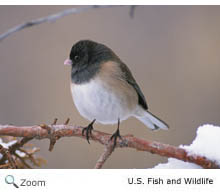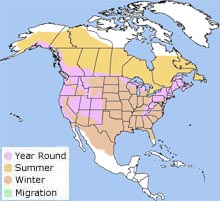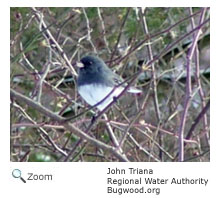Description
 The dark-eyed junco is 5-6½ inches in length with a wingspan of 9¼ inches. It is dark gray on its uppersides and breast and has a white belly and outer tail. Females are a little browner than the males, and they are slightly smaller. The dark-eyed junco is 5-6½ inches in length with a wingspan of 9¼ inches. It is dark gray on its uppersides and breast and has a white belly and outer tail. Females are a little browner than the males, and they are slightly smaller.
Range  The dark-eyed junco breeds from Alaska east to Labrador and Newfoundland and south to California, Arizona, and Texas in the western United States and south through southern New England in the eastern United States. It also breeds along the Great Lakes and in the Appalachian Mountains south to Georgia. It winters south to Mexico and Florida. The dark-eyed junco breeds from Alaska east to Labrador and Newfoundland and south to California, Arizona, and Texas in the western United States and south through southern New England in the eastern United States. It also breeds along the Great Lakes and in the Appalachian Mountains south to Georgia. It winters south to Mexico and Florida.
Habitat
The dark-eyed junco is found in the openings and edges of coniferous and mixed wood forests with dense ground cover. It tends to avoid forest interiors. In the winter, it is found in fields, along roadsides, in parks, and in gardens.
| |
Diet The dark-eyed junco hops on the ground in search of seeds and insects. During the breeding season, they prefer insects. In winter and during migration, they can be found at bird feeders.
Life Cycle  The male dark-eyed junco reaches the breeding grounds first. He sings from the top of a tall tree to claim and defend his territory. The male dark-eyed junco courts a female by spreading his tail and strutting around her while chirping and singing. The male dark-eyed junco reaches the breeding grounds first. He sings from the top of a tall tree to claim and defend his territory. The male dark-eyed junco courts a female by spreading his tail and strutting around her while chirping and singing.
 The female builds an open-cup nest of twigs, weeds, and grass. The male helps by bringing nesting materials. The nest is usually on the ground in an area hidden a fallen log, grass, weeds, or tree roots. The nest is made of bark, twigs, rootlets, and moss and lined with grass and hair. Occasionally, the nest is built close to the ground in a tree or shrub. The female dark-eyed junco lays 3-5 pale greenish-blue eggs splotched with brown. Incubation takes about 12-13 days and is usually done by the female. The male protects the female while she is incubating the eggs. Both parents feed and care for the chicks. The chicks fledge when they are about 9-13 days old, but their parents continue to feed and care for them for another three weeks. The female builds an open-cup nest of twigs, weeds, and grass. The male helps by bringing nesting materials. The nest is usually on the ground in an area hidden a fallen log, grass, weeds, or tree roots. The nest is made of bark, twigs, rootlets, and moss and lined with grass and hair. Occasionally, the nest is built close to the ground in a tree or shrub. The female dark-eyed junco lays 3-5 pale greenish-blue eggs splotched with brown. Incubation takes about 12-13 days and is usually done by the female. The male protects the female while she is incubating the eggs. Both parents feed and care for the chicks. The chicks fledge when they are about 9-13 days old, but their parents continue to feed and care for them for another three weeks.
BehaviorThe dark-eyed junco usually winters in the same place every year. They travel in small flocks of 10-25 birds. Not all dark-eyed juncos migrate, some stay in the same location year-round.
|


 The dark-eyed junco breeds from Alaska east to Labrador and Newfoundland and south to California, Arizona, and Texas in the western United States and south through southern New England in the eastern United States. It also breeds along the Great Lakes and in the Appalachian Mountains south to Georgia. It winters south to Mexico and Florida.
The dark-eyed junco breeds from Alaska east to Labrador and Newfoundland and south to California, Arizona, and Texas in the western United States and south through southern New England in the eastern United States. It also breeds along the Great Lakes and in the Appalachian Mountains south to Georgia. It winters south to Mexico and Florida. 
